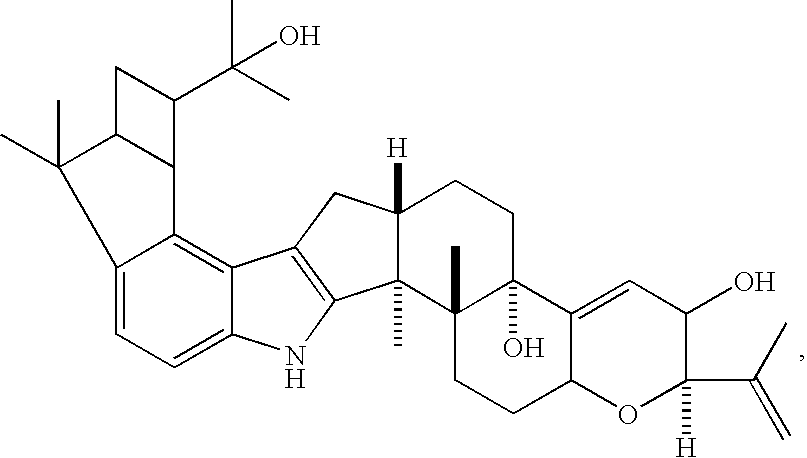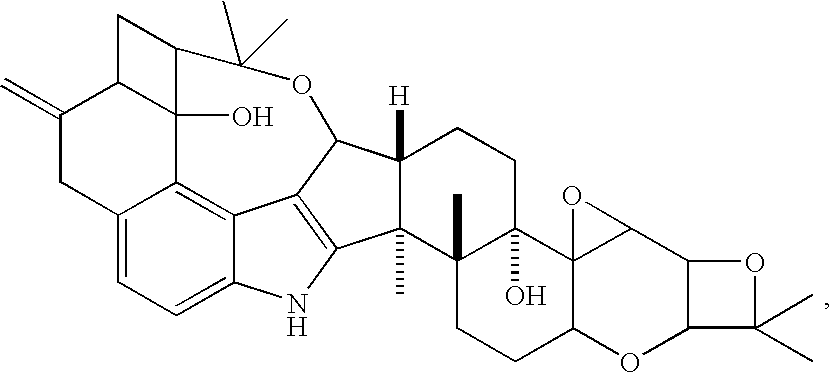Novel maxi-k channel blockers, methods of use and process for making the same
a technology of maxi-k channel blockers and k channel blockers, which is applied in the direction of biocide, heterocyclic compound active ingredients, drug compositions, etc., can solve the problems of unsatisfactory glaucoma drugs, unsatisfactory first-line drugs, and many of the drugs formerly used to treat glaucoma that are not satisfactory
- Summary
- Abstract
- Description
- Claims
- Application Information
AI Technical Summary
Problems solved by technology
Method used
Image
Examples
example 1
Electrophysiological Assays of Compound Effects on High-Conductance Calcium-Activated Potassium Channels
Methods:
[0080] Patch clamp recordings of currents flowing through high-conductance calcium-activated potassium (Maxi-K) channels were made from membrane patches excised from CHO cells constitutively expressing the α-subunit of the Maxi-K channel or HEK293 cells constitutively expressing both α- and β1-subunits using conventional techniques (Hamill et al., 1981, Pfluügers Archiv. 391, 85-100) at room temperature. Glass capillary tubing (Garner #7052) was pulled in two stages to yield micropipettes with tip diameters of approximately 1-2 microns. Pipettes were typically filled with solutions containing (mM): 150 KCl, 10 Hepes (4-(2-hydroxyethyl)-1-piperazine methanesulfonic acid), 1 Mg, 0.01 Ca, and adjusted to pH 7.20 with 3.7 mM KOH. After forming a high resistance (>109 ohms) seal between the plasma membrane and the pipette, the pipette was withdrawn from the cell, forming an ...
example 2
The Activity of the Compound can also be Quantified by the Following Assay
[0083] The identification of inhibitors of the Maxi-K channel is based on the ability of expressed Maxi-K channels to set cellular resting potential after transfection of both alpha and beta1 subunits of the channel in HEK-293 cells and after being incubated with potassium channel blockers that selectively eliminate the endogenous potassium conductances of HEK-293 cells. In the absence of Maxi-K channel inhibitors, the transfected HBEK-293 cells display a hyperpolarized membrane potential, negative inside, close to EK (−80 mV) which is a consequence of the activity of Maxi-K channels. Blockade of the Maxi-K channel by incubation with Maxi-K channel blockers will cause cell depolarization. Changes in membrane potential can be determined with voltage-sensitive fluorescence resonance energy transfer FRET) dye pairs that use two components, a donor coumarin (CC2DMPE) and an acceptor oxanol (DiSBAC2(3)).
[0084] Ox...
example 3
Intraocular Pressure (IOP) Measurements in Rabbits
[0090] Normotensive Dutch Belted rabbits (2.3 kg) of either sex are maintained on a 12-hour light / dark cycle during these experiments. Intraocular pressure (IOP) is measured using a calibrated pneumatonometer (Alcon Applanation Pneumatonograph), and results are expressed in millimeters of mercury (mmHg). Before tonometry, one drop of 0.05% proparacaine is applied to the corneas to minimize any discomfort to the animal. Two base-line (control) readings are taken at (−0.5 and 0 hr.) after which Compounds of Table 1 are administered topically (unilaterally applied into the conjunctival sac) in a 25 μl volume with the contralateral (fellow) eye receiving an equal volume of vehicle. A masked design is utilized, where the person involved in drug administration and measurement of IOP have no knowledge of the solutions' contents. Subsequently, IOP measurements are taken at 0.5, 1, 2, 3, 4, 5 and 6 hr after topical applications of drug. At t...
PUM
| Property | Measurement | Unit |
|---|---|---|
| diameters | aaaaa | aaaaa |
| resistance | aaaaa | aaaaa |
| pH | aaaaa | aaaaa |
Abstract
Description
Claims
Application Information
 Login to View More
Login to View More - R&D
- Intellectual Property
- Life Sciences
- Materials
- Tech Scout
- Unparalleled Data Quality
- Higher Quality Content
- 60% Fewer Hallucinations
Browse by: Latest US Patents, China's latest patents, Technical Efficacy Thesaurus, Application Domain, Technology Topic, Popular Technical Reports.
© 2025 PatSnap. All rights reserved.Legal|Privacy policy|Modern Slavery Act Transparency Statement|Sitemap|About US| Contact US: help@patsnap.com



